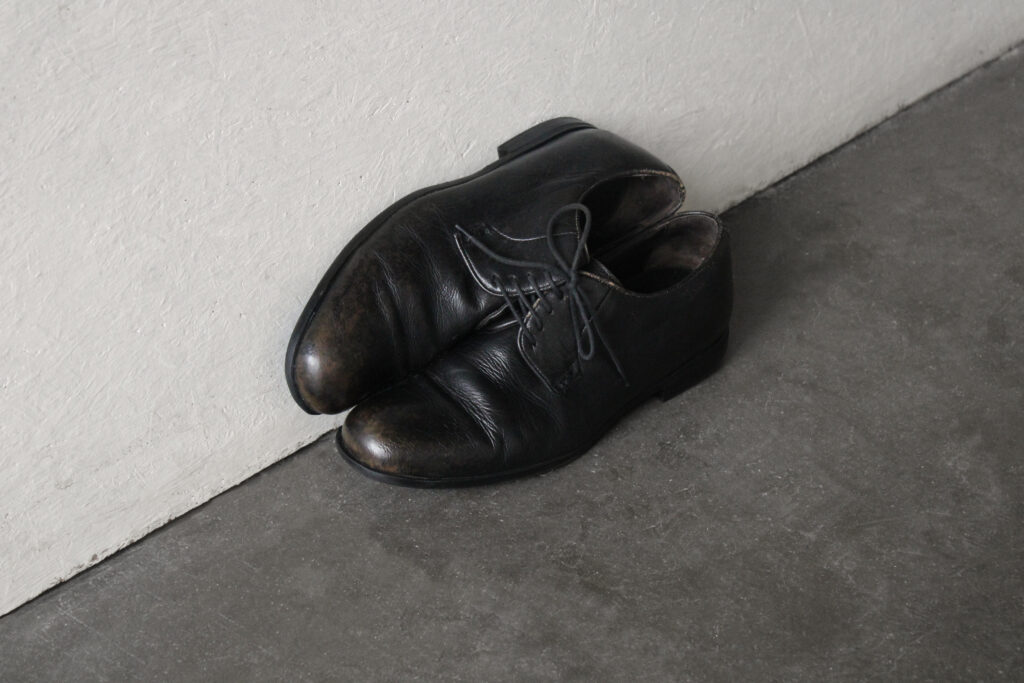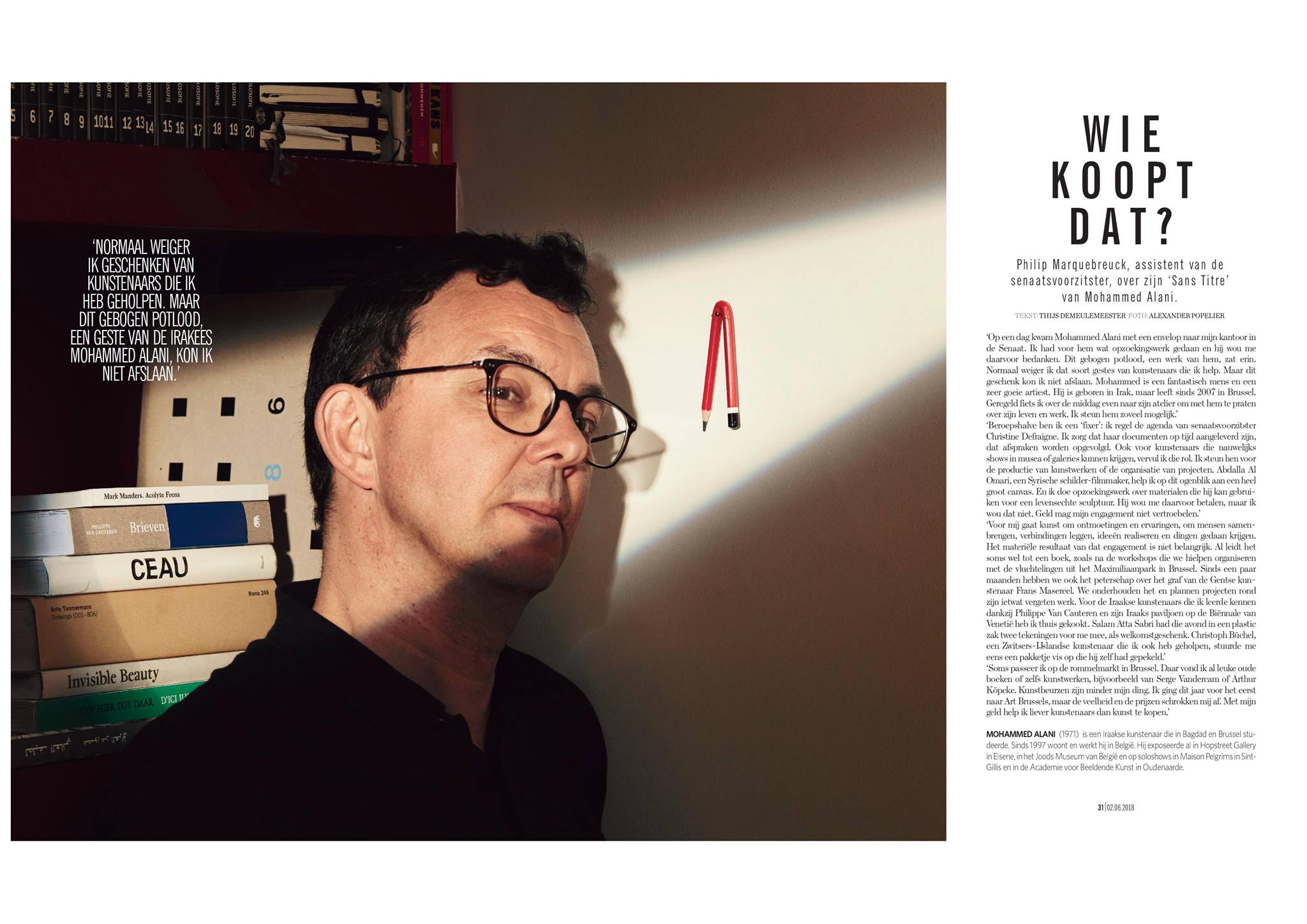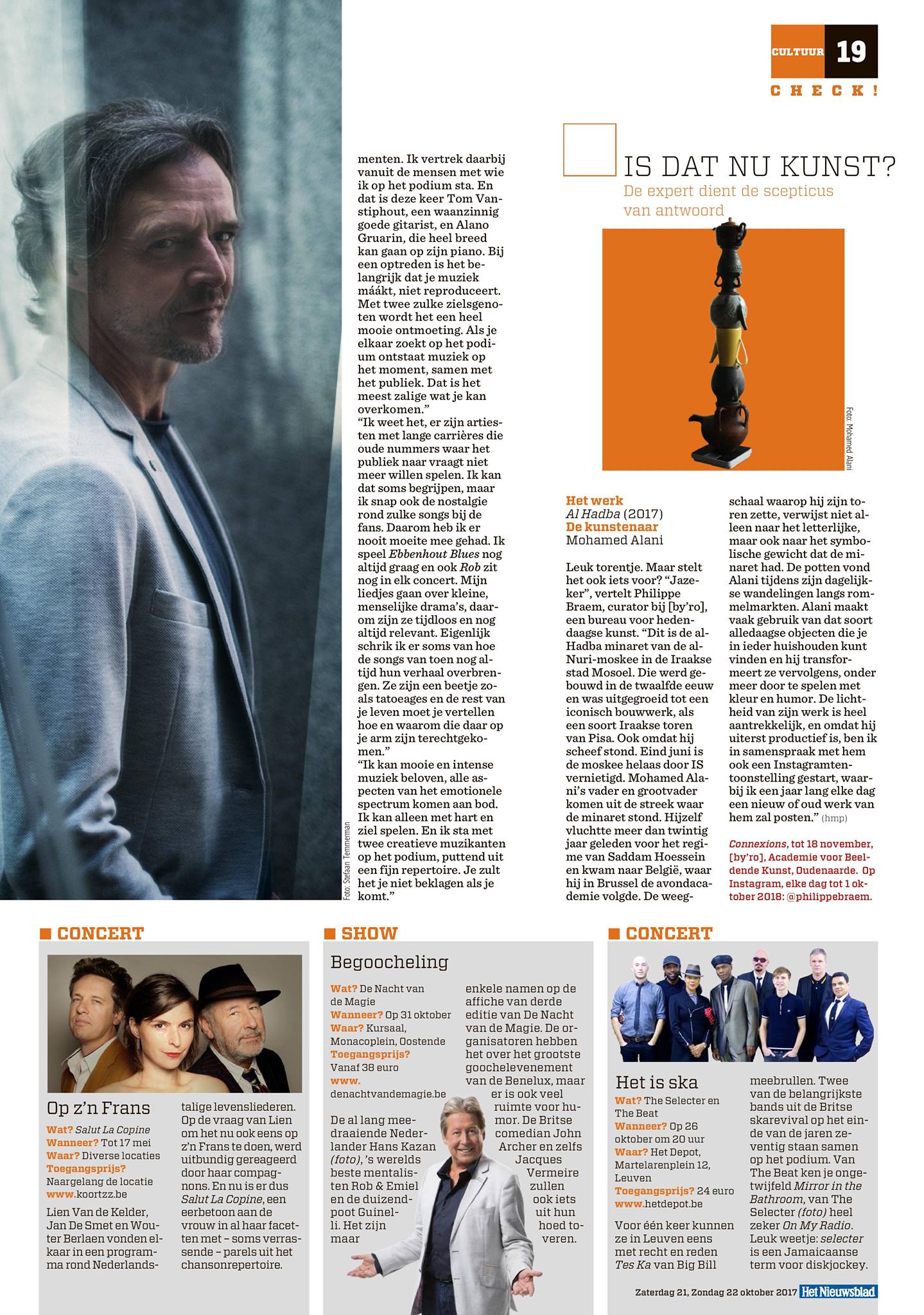PRESS
Philippe Van Cauteren
director of S.M.A.K. Museum for Contemporary Art in Ghent,
Letter: to Mohammed Alani
… It’s been almost 5 years since we met for the first time. I was preparing at that time, for the Venice Biennale, the Pavilion of Iraq, the country where you were born. The meeting was much more than a simple workshop visit. In a space somewhere in Forest, a sort of empty garage, you had prepared a small exhibition. You thought it was important that I could physically experience your work, instead of showing me a series of photos on your computer screen. The meeting was a real invitation to watch, to feel a transformation, to play a game. And this game, we call it art. It is essential to look in this way at the capacity to give, through the imagination, another meaning to things. The cap of a water bottle can easily become a city for a child. A stick from a tree can even turn into a bus. As an artist, you play, of course, but seriously, after having thought and weighed it carefully. What most of us kick out and throw away becomes the raw material for your artwork. And just like Picasso who put together a saddle and a handlebar on a bicycle to make an assembly, you bring together objects by linking them to each other, by juxtaposing them, by temporarily attaching them. Each work is like an idea, a photo that has not yet been taken, an impulse or a thought. It tells us where to look, invites us to connect form and space. In addition, the spectator often becomes part, protagonist, accomplice, especially in performances. The spectator becomes a carrier, a base, and therefore sees himself reduced to an object. The moments are modeled in the image of a sculptor who shapes a face in clay. Mohammed Alani borrows or quotes not only visible elements of recent art history, but also principles that he turns upside down. Nevertheless, Mohammed Alani is above all an artist who, intuitively, constructs images which enhance the banality of everyday life with playful simplicity.
February 23, 2018
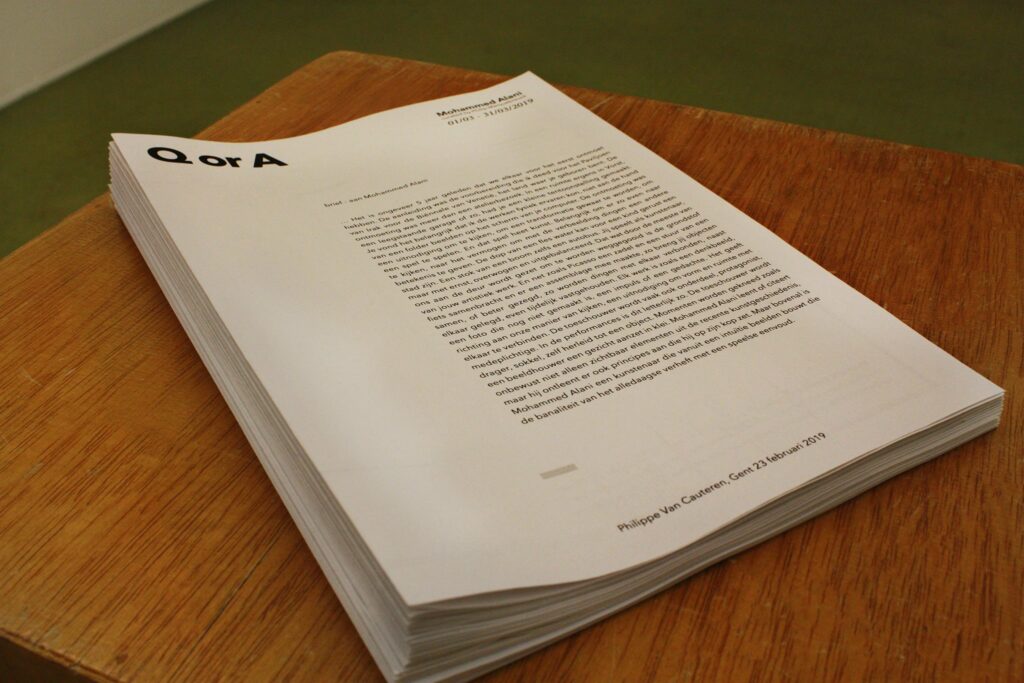
Visible memories
Mohammed Alani is using his memory of his cultural heritage and everything he has learned and seen to shape a simple piece of art composed of a brownish-red clay tablet on which something has been written in braille. What has been written, is like a code or a talisman to lock something as we can find in ancient Iraqi and Pharaonic civilizations: to close a burial place, on a royal seal, symbols and incantations to warn and scare intruders or the Sumerian tablets with cuneiform writings. It reminds us of amulets hung on the facades of houses to ward off evil spirits that were prevalent in Iraq and have their roots in the ancient Sumeria and Babylon: a turquoise circle with 7 holes in it. But it also reminds us of the holes in a horseshoe that is used in Europe against those evil spirits and was also hung on the facades of houses. Mohammed Alani was looking for the collective awareness of different societies and found what unites them, despite their differences in language and geographic location.
There have to exist common elements that bring people together and this is what pushed Alani to create a piece of art that everyone understands in order to create an artistic awareness. There is no better script than Braille because this is the only script people all over the world understand independent of their culture, language or color. The letters don’t differ from country to country like the letters of all other languages on earth, which do differ in form and pronunciation. This is the message of art: the creation of joy, fun, beauty, understanding and harmony. Mohammed Alani is putting the cohesion between people in the spotlight.
The form of the piece suggests that it is an sos message that was left behind alongside the road. Maybe someone that passes will offer help. This represents the catastrophic events in the Middle East that forced people to run like crazy, away from their devastated region and how they were received in Europe. Mohammed Alani has the intention to turn this into a memorial for human cohesion that becomes part of the collective memory.
As audience, we notice some sort of convergence and dialogue between what is written on the plastic tube and what is on the clay tablet. One can state that it is a dialogue between the past and the present. The plastic refers to the industry, the Industrial Revolution and the consumer markets while clay is as old as the earth itself and refers to the first humans and the ancient civilizations that were using clay instead of paper to write and as a base to make many things. The text on the plastic tube is also a digital print while what has been written on the clay tablet was done by hand. Nevertheless there is a connection and communication between the two, between the ancient and the modern world, because both are the heritage or mankind. There is no present without roots in the past and there is no future without the present. Mohammed Alani means that whatever kind of development or progress, people are still dependent on each other, especially in times of a crisis that unites them. So we come to the conclusion that this piece of art is a concept on human symbols that are traces that testify to their role in realizing human awareness. It gives us an exciting aesthetic form rather than its exaggerated interpretations.
Dr. Ahmed Khlaif Mankhi
translation: Sofie Van Den Abbeele
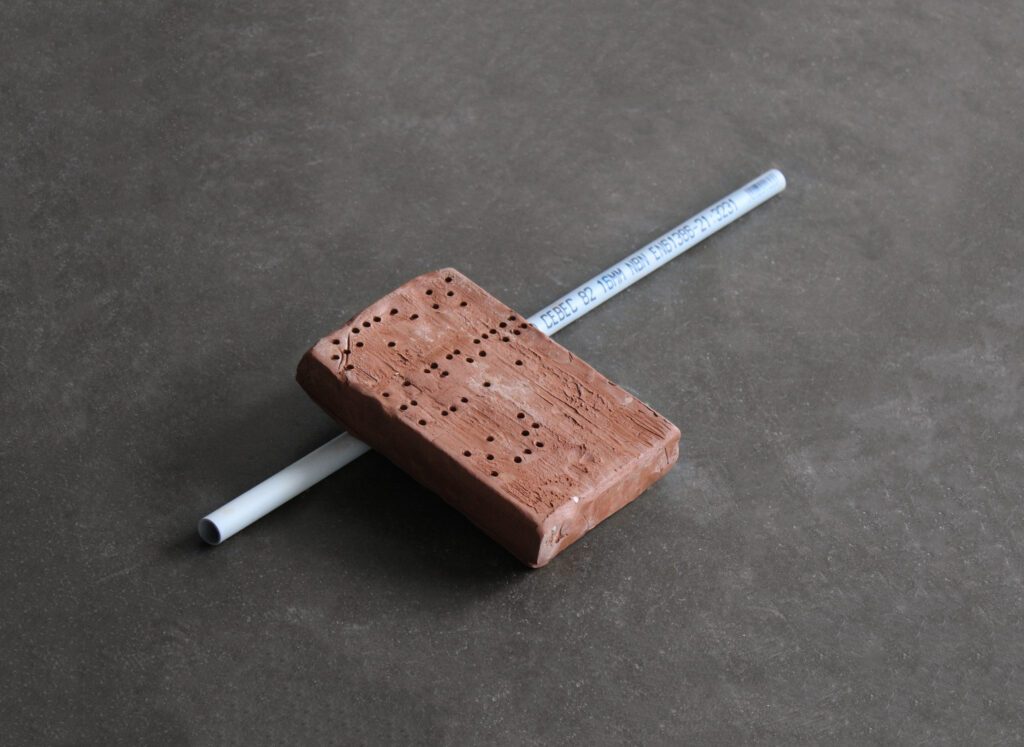
———————————————————————————————————————————————————————————-
Phantasy and reality
Everything in this life exists in different forms and positions and most people walk by without paying any attention to them. Only a trained eye can imagine these things in new forms. This talent enables them to exploit the environment in different fields. Life and art are examples of these fields, they are able to create beautiful shapes by connecting different things from our reality. This enables the artist to establish himself as the producer of interesting visual objects. Mohammed Alani has mastered the visual work that focusses on the idea of the physical existence, the existence that allows us to leave out traces in this life. These traces can differ from person to person. The characteristic of existence is the presence of a thinking being that understands the world around it, or as René Descartes describes it: “I think, therefore I am”. Existence according to Alani is the union of ideas and hands: the brain creates a plan and works together with the hands to execute it. This is not an easy nor an arbitrary process. Alani immediately gives us a symbol: the red cross. Even though this is a well-known symbol when seen on a first aid kit, he uses it to show us different meanings. The color red is known to symbolize danger and warnings, so why does he make this the base of his artwork? He wants to remind his audience that everything has a starting point and that this beginning, whether it is fast or slow, applies to all the materials used in the artwork. The metal of which several First Aid boxes have been made, is often used because it is robust and can withstand difficult circumstances. Yet these events can leave their traces and those traces are the start of the story of how it was used. Even though it has a bright white color, the signs of use on the corners raise questions: how many people have handled this box already? How often has it been used? What caused these traces? Neglect? A fall? Or was someone fidgeting with it? And why was it neglected? It raises a lot of questions, just like the story of the brick. Was it used in the building of a house or an institution? Was is part of a room of a fence? Of a child’s room? Or a woman’s or an old man’s? Was is discarded during maintenance or renovation of an old house? And what about the rope and the long piece of clay? The clay is like a pillar or a rock that has been subjected to natural forces that gave it it’s shape. Mohammed Alani gives us an idea of the life of the inanimate objects we use, but of which we have never asked ourselves exactly how useful they are to us and how they help us in our lives. We don’t appreciate them and see them merely something we discard when they have expired. This is why the artist gave them this shape, to appreciate these objects as part of a human life, resembling a totem. Especially the Native American wooden pillars with colorful shapes, but it also resembles African statues and even The Kiss from sculptor Constantin Brancusi.
Dr. Ahmed Khlaif Mankhi
translation: Sofie Van Den Abbeele
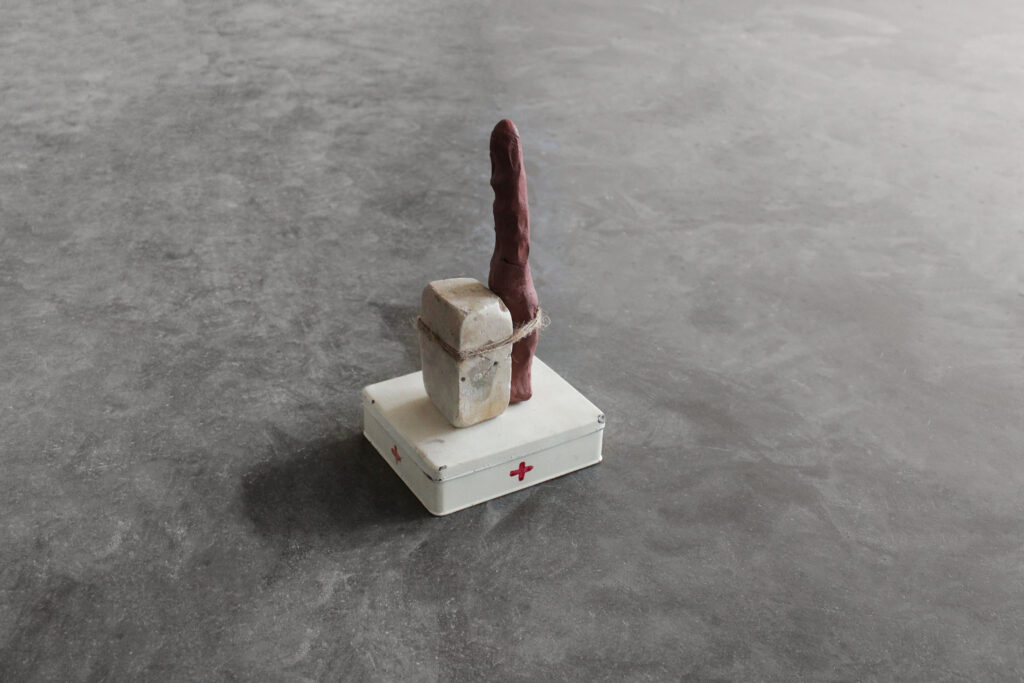
———————————————————————————————————————————————————————————————————–
Dialogue with oneself
Mohammed Alani tries to find a link between diversity and continuity based on a dialogue between everyday objects such as soap or a cork ball. These much used and diverse materials have been connected through a pencil which symbolizes human civilization. Without it, civilization would not have come into being, it is proof of the existence of ideas. All these objects differ in form and use, they are created out of pure industrial or a combination of industrial and natural materials, but what they have in common is that they are items used by man, each of them playing an important role in human life in their own way.
Mohammed Alani is using knowledge to create a link between things. Art as human knowledge is close to the human being. By means of intellectual dialogue, Alani visualizes the final form, generating a mental image of the end result of the piece of art. He successfully creates an aesthetic visual knowledge that amazes the audience and allows them to connect oneself, ones intellect and ones imagination.
Diversity is one of the characteristics of being, every existence in this world differentiates itself by means of color, form, hardness, weight and other physical characteristics. This diversity and plurality facilitates contact between everything that exists and the social nature of man, looking to create relationships to what exists, trying to determine what is useful to him and what not. The senses start this dialogue: touch, vision, taste, smell and hearing. By identifying beings and objects, he can create something for himself. For example some of the soft materials can be used to make clothes or shoes, while the hard materials can be used to fabricate tools. Perfumes can be extracted from objects with a nice scent, poetry is created with the pronouncing of words and instruments are used to create music. Like the DNA is the base of a male or female being.
Diversity in its outer form has impact on others, who can be fascinated by a piece of art, a beautiful building or an item they use either daily or from time to time. Without this diversity, everything would be boring, depressing and monotonous. The piece of music would consist of one note, the poem of a repetition of the same word and life would be one thing, one color. There would be no difference between women or man and woman, all would be duplicates of each other. Art would also be an endless repetition of the same work. How depressing and boring would life be if there would be nothing to draw our attention? We go to the movies to watch something full of diversity and plurality and the same goes for theater and food. The beauty of life is in its diversity.
Artists are using the specific characteristics of materials, especially in the previous century in work of Boccioni, Picasso, César, Arman, Chamberlain and others. Mohammed Alani is presenting this philosophy in a simple, visual way, in a successful attempt to enter in a dialogue with the ideas of mankind without ambiguity or delusion.
Dr. Ahmed Khlaif Mankhi
translation: Sofie Van Den Abbeele
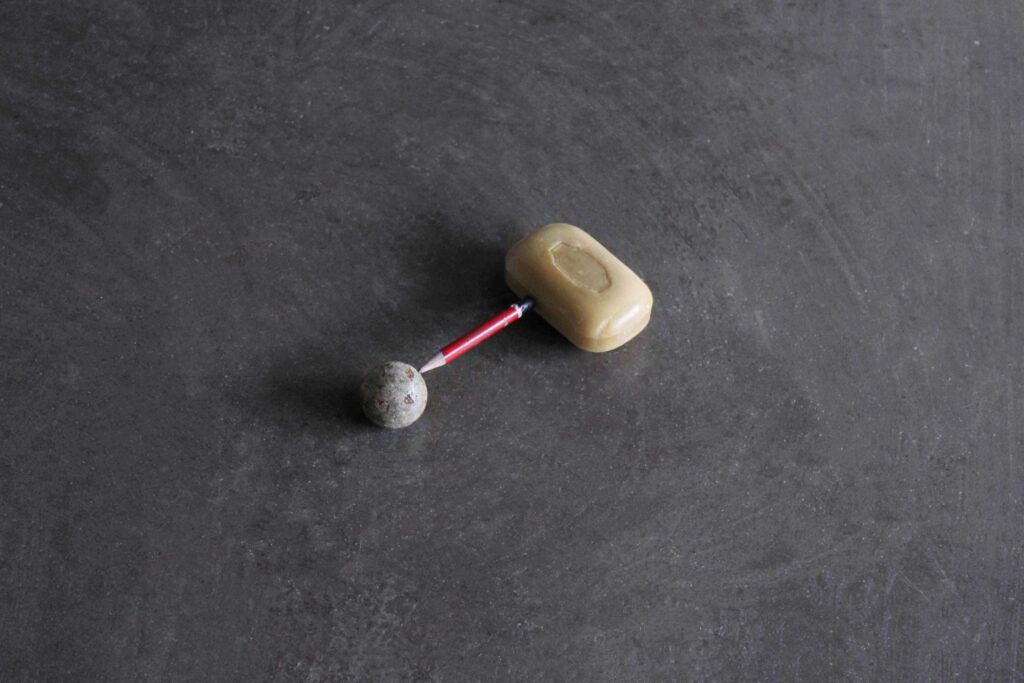
——————————————————————————————————————————————————————————————————————————–
The Beginning
Mohammed Alani is presenting us with stories about history from a beautiful and interesting cultural perspective. He does this with a piece of art showing an ochre tin can that got hit in the center, creating a deep dent and in the middle of that dent is a tennis ball. Despite the violent act causing the dent, it is a beautiful piece of art that has nothing to do with chaos and destruction. It reminds us of the Big Bang, the creation of the universe and the beautiful world we live in that all came into being through a chaotic event. No one can imagine this huge destructive force that we are the result of. It’s not an explosion as we know, but rather a chemical process mixing multiple materials in order to produce a new one. Mohammed Alani created an aesthetic process by merging industrial materials, resulting in a wonderful piece of art. The aesthetic process of this experiment continues in the interaction between de audience and the artwork. As there is a biological process happening among mankind represented by the formation of an embryo, The shape of the ball with the groove sitting in the tin can resembles a human fetus in its mother’s womb, referring to the beginning. Starting from one specific action and leading to many expected and unexpected results. This is the history of mankind from its dawn until today. The round shape of the ball, the size of an apple, also has more than one symbolic meaning referring to our daily life. The apple has had a huge impact on mankind. It is the reason man was sent down to earth from heaven according to several religious traditions. The apple also reminds us of Newton and how the apple falling down in front of him was the basis for discovering the law of gravity which was a huge scientific progress. And then there is Steve Jobs’ apple, that changed the world with its concept and new technology. The collision between the piece of art itself and location it has been placed in, evokes ideas of the absurd, the contradictory and the imaginary in this world. Planting this work of art in this environment is intended to break expectations, surprising the audience by using a location like the wing of a Classic Art Museum as a backdrop. This is our first impression of the piece, however the artist also wanted to declare that every beginning is different and with time will develop and grow to become something else. The Classic Arts didn’t come into being in the form we know now. It originates from the dawn of mankind on the face of this earth, starting with lines and vague symbols on rocks. Later these evolved into the shape of a mother goddess and continuing to evolve until it reached its peak during the Renaissance. This shows us that something incompatible can result in a new beginning. An idea starts with a small spark that develops into a creative achievement, whether the idea is artistic or scientific, it is like the embryo. The small piece of art contrasting with the location it is placed in proves that things shouldn’t be measured by size, but rather by their impact. Like the tiny screw that holds together the engine of the car. Like meteorites, some of them seem barely the size of a grape, yet they can light up the sky at night. Like a small bullet that can kill. And so simple ideas are more effective and influential than complex, exaggerated and colossal ones. We can see abstract art that is based on reduction and simplification, such as the work of Piet Mondrian and Joseph Boyes, who use small and simple proportions to convey a large meaning. Like the huge and gorgeous Pyramids in Egypt and the Iraqi cylinder seal which is no more than 3 cm, yet its splendor rivals that of the pyramids. And so artists, especially those belonging to the postmodernist era, illustrate the increasingly consumerist reality by using waste and especially metals. They have changed the materials used in art from alabaster and bronze to everyday, banal things that no one cares about, turning them into creative art that parallels the grandeur of Classical Art. For example the French artist César Baldaccini using metal plates and turning them into cubes using huge metal presses and John Chamberlain who also uses metal, especially from cars. Mohammed Alani merges two materials in order to produce a work of art. He didn’t opt for a lot of different materials like Rauschenberg did, nor did he use similar materials like Arman. It is a kind of controversy to say everything is measured by human standards because mankind is dominant in this world. Beauty is something that mankind perceives and enjoys differently in different periods of time. Every era has its own beauty standards. And so the artist is presenting beautiful material that tells the history of beauty through a contemporary piece of art, carrying us through different stages of human life.
Dr. Ahmed Khlaif Mankhi
translation: Sofie Van Den Abbeele
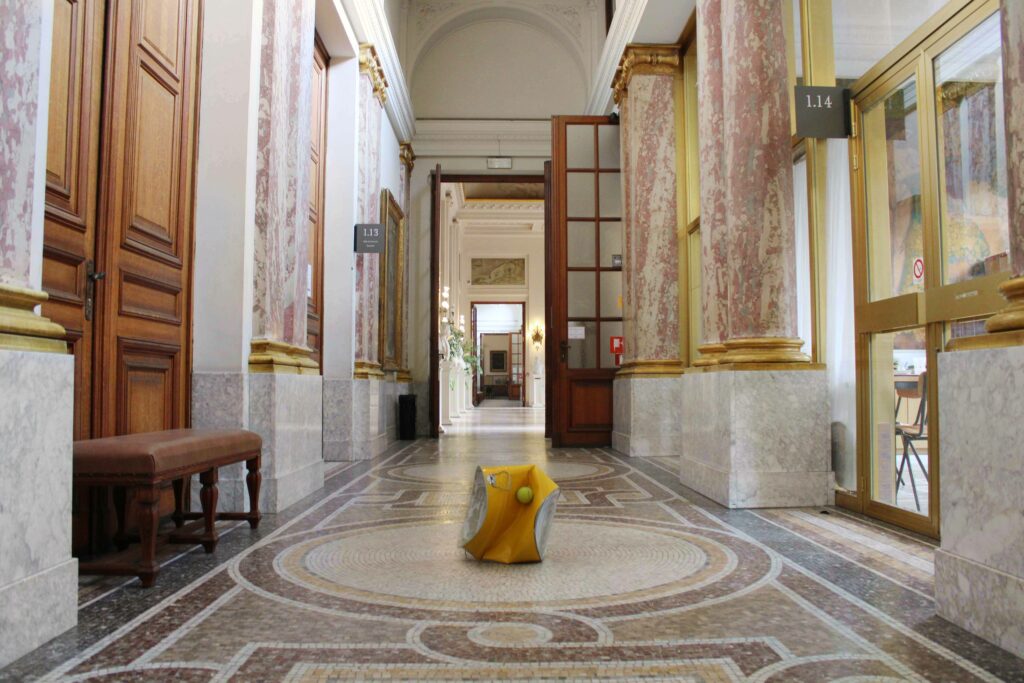
———————————————————————————————————————————————————————————————————————————
…..The artwork of the artist Muhammad Al-Ani simulates or talks about human reality with a simple presentation that is far from complex or visual dazzling, but rather presents his idea in a way that came from deep thinking and many experiences until it became like this, as it is full of deep philosophical ideas and visions that need to be meditated in order to open the locks of this simple and full With a different vision. The geometry consisting of tiles was placed in a basketball court located in a modern city. The players should see the presence and vitality of the place by the players, as well as the movement of pedestrians and cars, but the situation indicates complete calm and the place being abandoned by what happened to Chernobyl by a nuclear disaster, it is a depiction of a situation Anxiety and fear of an invisible enemy that cannot be felt or expected has swept the world silently and calmly, despite the pride of an elite group of countries in the world of the scientific progress that it has reached today of great achievements, but it collapsed by the action of an object that cannot be seen with the naked eye, so these achievements have become merely a profitable commercial marketing for daily consumption or use. The personal relies on visual and sensory stimulation for the purpose of marketing it, and the consequences of the disaster that brought the global economy to the arrival of major companies on the brink of bankruptcy and collapse. Consequently, threatening people’s lives by losing their jobs, i.e. their source of livelihood, and loss means misery and misery, and thus leads to the need that Victor Hugo warned about in his novel, The Misers. The loss of the presence of people leads to the cessation of life, as the artist cannot produce a work of art without watching it, as well as business owners from large to simple will lose their daily source of strength. There is a code sent by Muhammad Al-Ani through this shape, which resembles a residential building devoid of any life or suggestion of a human presence, as it is like a foundation stone or a monument to the horror that struck European cities. It is a stinging criticism of European reality as it represents the developed world, but it remained unable to find a real solution For this epidemic, and the most strange, that each of Europe and America from the most continents of this dreaded epidemic reaped a lot of people’s lives more than the countries of the third world. Is this not surprising compared with the capabilities of the third world countries. It reminds us of a situation that occurred in the last century that led to the flight of many Europeans During World War II to the Middle East, will Europeans resort again to countries less affected by the epidemic? The depiction of Elias and Raib by Muhammad Al-Ani reminds us of the works of the artist Giorgio de Chirico, which is dominated by anticipation, anxiety and depression. Muhammad Al-Ani depicted a state of Surrealism that departs from the dreamy surrealism of Salvador Dali in which there is something of romance and close to the surrealism of Koya full of ghosts, anxiety and fear and its object depict a state of mental disorientation and intellectual disorder. And also the work reminds us of the Rubik’s cube and the world being a strange riddle that cannot be understood and that it is linked to a kind of spells and hidden powers that form it according to what you want or as a supernatural game that changes if Someone tries to play or tamper with it as portrayed to us. Jumanji movie about a game that has the role of causing coups and change Reality, although it is a game that no one can expect to be triggered by a mere game in the life of everyone who plays with it, as well as a reference to the mythical thinking of previous civilizations and peoples that explain the phenomena that they cannot explain are due to metaphysical forces. So, we find more reflection on the work that we find in the form of a vertical brick. Amidst the unknown, the brick is a symbol of construction and progress, and its discovery is a revolution in the world of human knowledge in the field of architecture, which was discovered eight thousand years ago in Mesopotamia, and here is the tile waiting for someone To turn it into an urban achievement or a scientific solution to the epidemic. Can the world overcome this ordeal with minimal losses? .
Dr. Ahmed Khlaif Mankhi
translation: Sofie Van Den Abbeele

————————————————————————————————————————————————————————————————————————————–
Material: a pair of shoes
….The artwork is represented by a pair of black-colored shoes tied to one ribbon, so form an angle where one of the shoes is on the ground and the other shoe touches the wall, meaning that the shoe is suitable for displaying it at the angle where the ground meets the wall. It is noticeable in the artwork that the artist Muhammad Al-Ani used the ready-made object as a work of art He refers us to Marcel Duchamp’s ready and circulating employments, except for the artist Muhammad Al-Ani. He added something relatively small and placed it in a large exhibition space that might not arouse the eyes as a great work of art does, but the artist’s philosophy believes that it is better to create intellectual concepts because the wide place has a psychological effect that stimulates reflection and thinking. Interpretation to receive the artwork and here is interesting to note, we find that the artist did not give a name to his artistic work or sign it, and this is a feature of this Belgian artist’s features and here he tries to announce himself not by leaving a name or signature of the artwork, but by leaving an artistic effect that suits his artistic style and orientation And his aesthetic philosophy is that we often use and buy shoes and we do not care about them as an aesthetic value. It ends with the end of the fashion season with which it is related. It is an attempt to draw our attention to contemplate the surroundings of our lives well and think about what is around us, no matter how And there are other cases that refer us to this work, which is pop art in Andy Warhol’s works and his works that present ready-made commercial things, which are considered as a commercial advertisement for some products that he makes as works of art. Al-Ani does not show the name or brand of the shoe, as he is interested in the artistic presentation, ie he tries to establish an aesthetic, artistic and intellectual dialogue with the recipient based on the style of presentation and not on the presented material or its name as Andy Warhol did, and the artist Al-Ani tries to create a dialogue that is contrary to the dialogue of Warhol that belongs to the last century And the artist is to give an artistic concept to what suits the great variables of this century and Al-Ani has made his artistic work very simple, moving away from complexity. Here, he is discussing the spirit of the new era represented in the wide consumer values that provide all available services within a simple framework that may change or make amendments to The shape of the pair of shoes, whether by adding a color or other material, but keeping them as they are, here we find the artist reminds us of what the artist Claes Oldenburg made, who used to enlarge things for large works, but the artist Al-Ani found that the size of things was It gives more effect, aesthetics and realism. When enlarged, it will lose a lot of its essence and turn into something else. Likewise, this work refers us to minimal. art and the artists of this trend who leave things on the ground, whether they are metals, fibers, or stones in different ways of presentation, some suggest that they are not arranged and some are arranged geometrically or non-geometrically. This is evidence of this artist’s awareness of understanding contemporary artistic reality.
Dr. Ahmed Khlaif Mankhi
translation: Sofie Van Den Abbeele
—————————————————————————————————————————————————————————————————–
Material: a matchbox of paper and two dice.
…The work is embodied from a matchbox with two dice inside, and the matchbox has opened a hole the size or length of the dice, and the dice have taken up space or the upper part of the matchbox completely This gave the feeling that the box was full of dice and the matchbox was placed directly on the ground. The simplicity is represented by the artist Muhammad Al-Ani, as he did not use complexity In proposing his idea through the artwork, and he selected things carefully and thoughtfully planning and directed them in this way, he certainly made a lot of experiments until he settled on this formation Final. The artist has warned about the importance of the small thing, and we do not care about small things despite our frequent use of them, but we do not look at them despite the accuracy of their manufacture. The method of presentation alerts us to the fact that the things that we throw or that are on the ground that do not arouse any importance to passers-by when they see them, despite their special aesthetic kind, it is presented to us The artist is a work of art based on conceptual values, visual dazzling and unpredictability, so that the recipient does not expect the artwork to be of this size and was presented on the ground, so he expected that It is displayed in a distinctive, elegant place, perhaps because of its size. There may be many viewers who do not notice it and may be accidentally crushed with their feet or some think that it is just garbage Perhaps he wanted viewers to see their reaction to this work and what they comment, and it can be considered as a kind of alert to everything we see, in which there is privacy, thought and beauty if they can Seeing differently or changing our vision of our surroundings. The work achieves an intellectual dialogue between the recipient and himself, and this dialogue continues for a long time with the recipient trying to set answers for each Questions that passed through his mind. The use of ready-made objects circulating in society as works of art reminds us of the works of Marcel Duchamp, such as the bearer of the bottles and the shovel of snow, as well as the works of pop artists as Andy did. Warhol uses Coca-Cola cans, brillo cans, and Campbell’s soup, as well as Roshambirke’s doing by employing ready-made things as part of his artistic work, except that the artist Mohamed Al-Ani One ready-made thing was not employed, but rather the merging of two ready-made things. What distinguishes the artist Mohamed Al-Ani is that he did not adopt a specific artistic direction or ideology, but rather he was interested in aesthetic artistic proposals with aesthetic values. And with a clever critical vision, the dice suggests to us what we do like a gamble that depends on luck in this world, and this is what the matchbox hole suggests, as if it reminds us of an experiment or action we are doing and The results depend on what we do, as if it were a dice. You need luck despite our great capabilities, and this is what we saw about what happened to the world in 2008, which occurred the crisis The global financial system that toppled the gigantic sober companies that declared their bankruptcy, and this process was repeated as the Corona pandemic swept the world. The artist has achieved shifts, both at the level of The style, directing, display and employment, which made the recipient move to unlimited multiple shifts for what he received from unconventional proposals, so these called for actions, ideas and feelings Full of poetry and passion, she tries to search in various directions and arts through memory, and the artist Muhammad Al-Ani succeeded in controlling and drawing the recipient into a circle and influencing him. Intellectually, artistically and aesthetically
Dr. Ahmed Khlaif Mankhi
translation: Sofie Van Den Abbeele
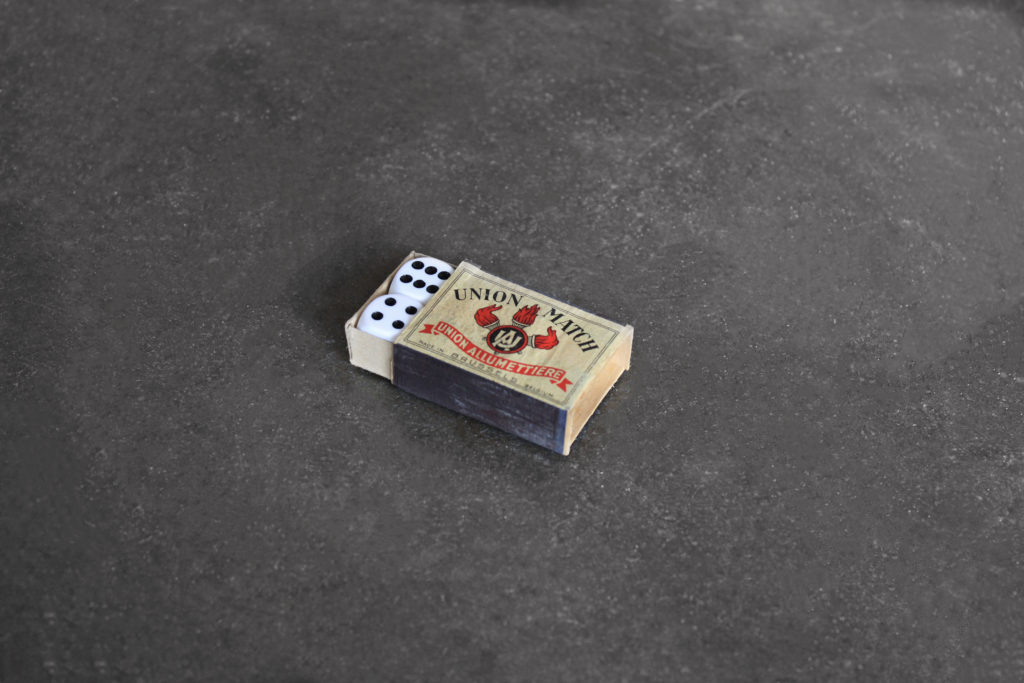
——————————————————————————————————————————————————————————————————————————–

